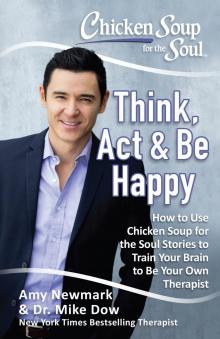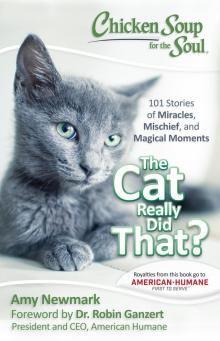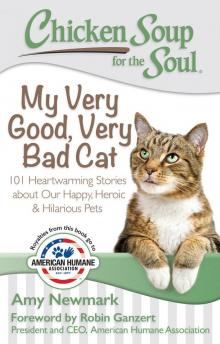- Home
- Amy Newmark
Chicken Soup for the Soul Page 9
Chicken Soup for the Soul Read online
Page 9
For we are connected, one and all.
~Deborah Day
I was fifty-three — a healthy, athletic, vegetarian, non-smoking daily runner. How could I have breast cancer? Nobody else in my family had ever had it.
I barely had time to process the news from my doctor, what with all the appointments, X-rays, and consultations. After several weeks, we had a plan. The cancer was very small. I would have a lumpectomy with radiation — to make sure nothing was left behind. I was going to the University of Michigan Rogel Cancer Center, a premier medical center. I was in good hands, and the treatment was straightforward. In a few months, it would all be behind me. I was one of the lucky ones — stage 1 cancer, great surgeons, early detection, a supportive husband and wonderful friends, including the seven girlfriends I ran with every morning.
After the lumpectomy, my doctor gave me a thumbs-up. Everything went well. She felt sure the surgery had gotten beyond the borders of my cancer, and the radiation would be just an insurance policy. Then, five days later, I got the phone call.
The cancer had spread. My doctor had biopsied one of my lymph nodes, and it was cancerous. I put down the phone and cried. All my natural optimism drained away. This meant more surgeries and chemotherapy. All those upbeat proclamations from my doctors were no longer true. I really might die.
I had more biopsies and surgeries to remove lymph nodes. Then I spent an entire long summer and fall in chemotherapy. By the time it was over, I looked like a bald, skinny chicken heading for the chopping block. My running girlfriends, who had been bringing me chicken soup for months, switched to chocolate-chip cookies and cheesecake in an effort to fatten me up so I could get back on the running trail. But I was so wiped out that I spent most days in a huge leather chair reading books on overcoming cancer. And I still had radiation to go through.
I didn’t want to make the long round trip to the University of Michigan for radiation every day for six and a half weeks, so I found a hospital only eight miles away from home.
“You don’t need to drive me,” I told my husband Paul. “It’s close enough that I can drive myself.”
He crossed his arms and looked at me for a long minute. “It’s close enough that you could bike it.”
“Huh?” I could barely muster the energy to walk to the mailbox.
“You can do it,” he said. He pulled out a map and a highlighter and drew a route from our subdivision, down side streets and other neighborhoods, through a little woods and finally to a long, wide sidewalk that ended up across the street from the entrance to Henry Ford Hospital radiation center.
“I’ll bike with you the first time,” he said.
I was exhausted, but I was also tired of feeling like a punching bag. Suddenly, I wanted to do this, to prove that I still had some control, even if it was only choosing how I got to the hospital every day.
That first morning was a slog. Paul led the way, and I pedaled behind slowly. It was the very end of August, hot and dry. Little kids running through sprinklers, people washing their cars and other bikers waved at us. I felt a little confused, like I didn’t belong out there in the world with the rest of the people. Could I really bike eight miles? And then turn around and bike eight miles back home? I hadn’t done anything physical for months. But this bike ride on this day had become an answer to all that I had been through — the beginning of my journey back to myself. After my radiation, I came home and collapsed in the leather chair for the rest of the day. I felt like I had climbed Mt. Everest.
Paul biked with me the next couple days just to make sure I knew the route, and then he had to get back to work. “You can do it. You know you can.”
I nodded, put on my bike helmet and went outside. There, next to my bike, was Anita — blond, fit and smiling. She was straddling her bike. “You ready?” She laughed at my expression. “If you can’t run with me, I’ll bike with you.”
And that’s how it began. Anita biked the eight miles with me that day. She sat in the waiting room during my radiation treatment, and she biked the eight miles home with me. The next morning, Nelle was waiting outside. And then Jan. I had known my girlfriends for years. We had run together and raised our kids together, through thick and thin. Who knew that what I thought was a “thin” would turn out to be such a “thick”?
With my girlfriends beside me, I looked forward to that bike ride every day. We told jokes, chewed bubblegum, and sang old pep-rally songs. We complained about the heat, and then we complained about the cold when autumn arrived. Anyone seeing us laughing and chatting away never would have guessed our destination. I didn’t care what the weather was like anymore — I was on a mission, and I was getting stronger. I would never drive to radiation. It could rain — and it did. Still we biked. The temperatures dropped into the low thirties. Jan and I put on long underwear under our sweats — and biked away.
Our cheerful chatter as we burst into the cancer ward morning after morning attracted attention. The nurses watched us through the glass doors as we dragged our bikes into the anteroom. They cheered our fortitude when we peeled off dripping rain gear. My doctor, who knew of my “mission,” asked me every morning if I was still biking. One rainy morning when I biked through a muddy patch, my tire slipped, and I went down, slicing my knee. The crowd in the waiting room parted for us as I limped in, torn and bloodied, and I was taken immediately to the doctor. Even with injuries, even through the rain and the cold, Doctor Gable never told me not to bike. She said, “Keep it up. You’ll be stronger when this is over.”
And, one day, it was over. Anita and I biked the last eight miles to the hospital one cold day in October. The nurses cheered as we entered. Doctor Gable appeared in the waiting room. She held out her arms, and I walked into them. “You did it.”
Yes, I did it. But it was Anita, too, and all my friends. It was Paul and Dr. Gable. It was the sun and the rain and the woods and all the people we biked past every day. What a gift it was to be alive.
— Ingrid Tomey —
Playing All the Angles
Turn your obstacles into opportunities and your problems into possibilities.
~Roy T. Bennett, The Light in the Heart
“Yes! Yes! I did it, I did it!” I shouted as I jumped up and down in exhilaration. Okay, maybe I was a little more exuberant than the occasion called for. I had just beaten my wife at pool, banking a shot off the bumper and knocking in the eight ball in the game room of our building. From my reaction, you would have thought I took down Minnesota Fats in a winner-take-all billiards match.
Before we moved in, pool was not my game of choice. I had played at times growing up, but I wasn’t very good at it and never developed a fondness for the game. However, we had vowed to use the amenities in our new residence, and thus we were shooting pool. My wife and I played once a week, and we usually found the table unoccupied. It seemed like our private game room, and I even found myself playing games against myself on my days off.
As time went by, I started to improve. I also enjoyed playing more than I ever had in the past. I felt confident enough in my game to say that I was not bad. I wasn’t running down to any pool parlors to hustle the locals, but I had a newfound appreciation of the game.
One Sunday night I had a breakthrough. I suddenly started to visualize things on the table that I didn’t know were there or even existed before. As a novice, I had only seen the obvious shots in front of me. But now I started to see all kinds of options that were previously missing. Maybe they were hidden by other balls impeding their path, or I would need to have taken advanced calculus to figure out the angles to make it work, but a whole new world of possibilities opened up for me.
What I didn’t realize until that day was how shooting pool imitated life.
It didn’t all come to fruition that night. As part of my effort to improve during the previous months, I practiced different shots just to see what happened. If there was a gimme available or a shot that required more skill, I opted for the tougher option. It
was easy to take the path of least resistance, but it was much more rewarding when I accomplished something I had thought was out of my reach. I figured the easy alternative would still be there, and I could learn how the ball bounces, so to speak, when going out of my comfort zone.
I was amazed by my discovery. I didn’t just see balls on a table. I saw answers to life’s questions by seeing what wasn’t always visible to the naked eye. Some would say I was “thinking outside the box,” but I think the term has become a cliché. I learned to look beyond the obvious and open my mind to different ideas and solutions than I previously thought possible.
I give myself the chance to make decisions that will give me the outcome I want.
Now I don’t just accept what’s in front of me. I give myself the chance to make decisions that will give me the outcome I want. I look at things from every angle; I play every angle.
When I play pool, I examine every option before I commit to a shot. I want to make sure I have left nothing to chance. I ask myself: Is there a better opportunity somewhere else on the table?
It’s amazing how pool mirrors life. You can set yourself up for your next shot if you execute properly. In the game of life, every adventure or step along the way creates a pathway to your destination.
The answers are there if you search them out. You have to put in the work. Getting better at pool or at life takes practice. As I was getting better at pool, I got cocky and tried to jump steps ahead before I was ready. When I didn’t give a shot the time it deserved, I failed. I saw the folly of my ways and recommitted to staying consistent and sticking to the plan.
When I look at the table now, I know what to look for. The answers aren’t always there, but I keep searching to find them, whether it’s experimenting with a shot to see what happens or setting myself up for the next opportunity before me.
Having spent my life in sales, I’ve learned the wisdom of this saying: “Until you get your first ‘no,’ the process hasn’t even started.” I can choose to see a situation as hopeless, or I can visualize the possibilities, whether it’s on the pool table or in my life.
That breakthrough changed my life. One minute, I saw the same table I had looked at countless times before; the next, a totally new vision popped up out of nowhere. Now I rack them up, break, and watch the balls scatter. And not just when I’m playing pool.
— Darrell Horwitz —
I’m Wonderful!
The habit of being happy enables one to be freed, or largely freed, from the domination of outward conditions.
~Robert Louis Stevenson
When I was a young mother, I decided to venture into the workforce. I needed a job that would allow me to be home with my children when they needed me most. Tupperware home parties were the answer for many of us during the 1960s and 1970s. I was fortunate to have an incredible trainer who not only developed in me a positive mindset, but also left me with a winning outlook on life.
I can still hear her first words in our training class: “Hi, class. How are you?” The answers varied around the room — fine, okay, scared, etc. But her next words have stayed with me forever: “That is a polite question. No one but your mother really cares about an honest answer!” From then on, when asked how we felt, we all said, “Wonderful!”
I made “wonderful” part of my everyday language. One morning when I went out to get the newspaper, my neighbor said, “Hi, how are you?”
I replied, “Wonderful. How are you?”
She said, “Are you always wonderful? Don’t you ever have a bad day?”
“Sure, I do,” I said, “but if I told you all my problems, it wouldn’t make either of us feel better. Plus, saying ‘wonderful’ keeps me thinking and feeling that way.”
Feeling “wonderful” is a choice every day. It’s certainly easier to give in to the pressures of life, to let negativity invade our minds and souls. However, saying “I’m wonderful” at least once a day can become a habit that will change your life and the lives of those around you.
Feeling “wonderful” is a choice every day.
Several years into my Tupperware career, my trainer (now mentor) asked that I start teaching her classes. I was excited every day to teach all the life-changing lessons I had learned. Of course, every class began with “I’m wonderful.” My new attendees were aspiring Tupperware managers. They had heard and hopefully said, “I’m wonderful,” many times by now. After my class, one of my students approached me and said, “You always say you’re wonderful, but you can’t be wonderful all the time.”
I looked at her and responded, “My grandmother is dying! I have three teenage daughters who are a handful! I’m going through a divorce! I may have to sell my home! And I have a yeast infection! Does that make you feel better?”
She said an immediate “No,” and I said, “Well, it doesn’t make me feel better either! So, I’m wonderful.”
Everyone has their own problems and daily issues. We can choose to share them with the world and all feel bad together, or we can simply say “wonderful” and change the dynamic!
— Kristine Byron —
How I Rebuilt My Life Using the Joy Test
Change your thoughts, and you change your world.
~Norman Vincent Peale
I knew I’d made it when I drove to my former house to pick up the kids and felt, well, nothing. Those ugly pangs I’d felt driving up into that stylishly hip enclave each week for the past two years? Gone. The lurch of emotion I’d felt when their dad came to the door to wave hello? Also gone.
Instead, I felt peace. I looked at the beautiful landscaping I’d overseen, the terraced river rocks and weeping cherry trees. I looked at the car of my ex’s new partner parked out front and thought, It all worked out.
I was deeply proud of that feeling because I had never worked so hard at happiness in my life.
I had known, when I decided to leave two years prior, that I had a lot of work ahead of me. I had made the decision one cold Monday morning — the same week I lost my lucrative law job and just a few months after my mother’s sudden death. I’d been waiting for the right moment, and that was it.
I knew I had the moxie to rebuild the external parts of life, like a house and job. But I didn’t know if I could do the really hard part: move past the anger and hurt that had marred much of our eighteen- year marriage. I didn’t know if I could fully mend my internal life.
My mother never fully recovered from her own unhappy forty-three-year marriage or from my dad’s decision to leave her at age seventy. She made a brave effort after he left, but she also cut his picture out of every photo album, filled spiral notebooks with rage at the “SCOM” (self-centered old man), and recounted each point in her life when she knew she should have left but didn’t. Although she found peace and forgiveness during the very last month of her life, neither that nor dementia erased the decades of pain she had endured. Anger kills.
I wasn’t exactly sure how to go about reshaping my internal life, so I just felt my way. Looking back, here’s how I did it:
1. Ban anything that doesn’t bring joy.
2. Actively seek joy.
3. Work at gratitude in general.
4. Work at gratitude toward my ex.
5. Repeat steps 1–4, as needed.
6. Presto! End up at forgiveness.
If I had read a list like that two years earlier, when I was scared and alone, waiting for my real estate agent to show me yet another so-so house, I would have tossed it in the trash. I didn’t have the list back then, but as I felt my way along, the strategy developed.
Those first few months, I used the Joy Test for everything. I’d only let people or things into my new life that brought joy. How would I know? I’d sit still and focus on that inner voice, the one I had ignored for so many years as I sought status and stability instead of true happiness.
I used the Joy Test to buy my first house. I was unemployed, and it was the bottom of winter, so I did not have a lot of options. Still, I e
ventually picked a sweet little house that felt relaxing the minute I walked in. It was not fancy, but it felt like home.
I furnished that house the same way. I brought next to nothing from my marital house. I wanted to start over. My rule was that if I didn’t love it, I didn’t buy it. Canopy bed with gauzy curtains so I could pretend I lived in a hacienda? Yes! Stuffy dining-room set that I would rarely use and would remind me how much I disliked dinner parties? Nope.
It was the same thing with my job search. I kept interviewing until I found a great fit. At times, it was humiliating to watch the cars leave my block every morning while mine sat with nowhere to go but yoga class or the grocery store. I told myself I was on “sabbatical” and I was lucky to have such a low-key life.
I only invited people over whom I trusted. People make a lot of offhand comments about divorce, not understanding it’s something that no woman wishes on herself and no mother wishes on her children. Those gossipmongers who were eager to tell me about my ex’s new girlfriends? Bye. The friend who also lost her job and marriage at the same time and sat with me on my pretty porch every morning? I will love her forever.
Since I am not passive about anything, I also decided to seek out Joy actively. I thought about the things that made me truly happy and did them. I joined a friend in New Orleans for Jazz Fest and spent the weekend in her wake, buoyed by her infectious spirit, rakish fedora and easy laugh. I celebrated a friend’s birthday in Spain, reveling in the beauty of the place and of women’s friendships. I grew my hair longer and started wearing skirts. I became a competitive, open-water swimmer. I never looked, or felt, better.
I decided to date, but only if it included dancing. Dancing has been a source of joy for me since I started sneaking into nightclubs at age fourteen, and I wanted to be with a man who understood that. I was lucky to find him on my first try. Like me, he was newly separated and heartbroken. Like me, dancing had been the center of his young life and was still a part of his mature one. We met, clicked, and started dancing it all out together. We signed up for ballroom dance lessons because the dancing — and relationships — that had defined our youths were over. We were both eager to grow, as dancers and partners.

 Chicken Soup for the Soul
Chicken Soup for the Soul The Joy of Less
The Joy of Less Hope & Miracles
Hope & Miracles The Cat Really Did That?: 101 Stories of Miracles, Mischief and Magical Moments
The Cat Really Did That?: 101 Stories of Miracles, Mischief and Magical Moments The Joy of Christmas
The Joy of Christmas My Very Good, Very Bad Dog
My Very Good, Very Bad Dog My Very Good, Very Bad Cat
My Very Good, Very Bad Cat